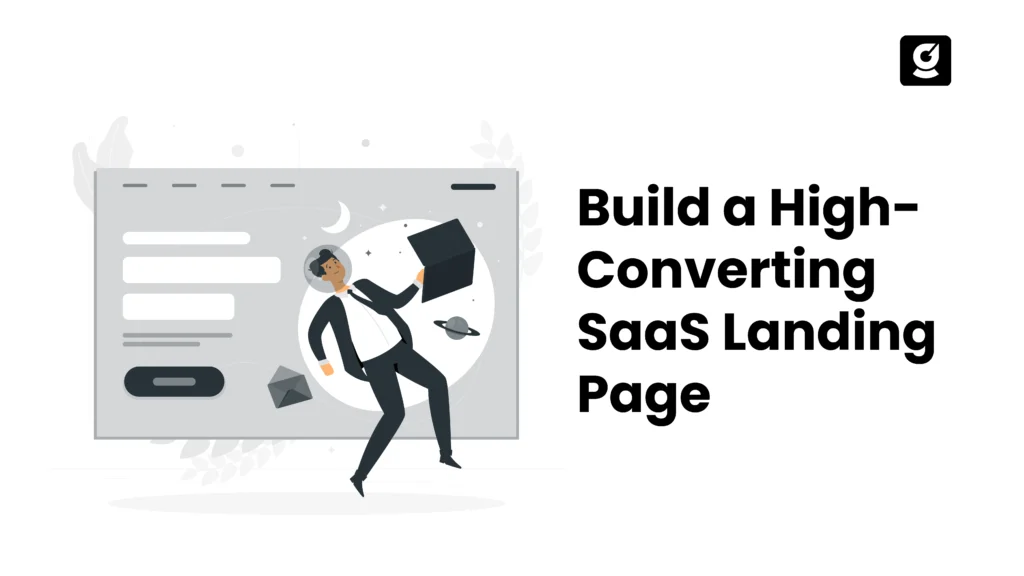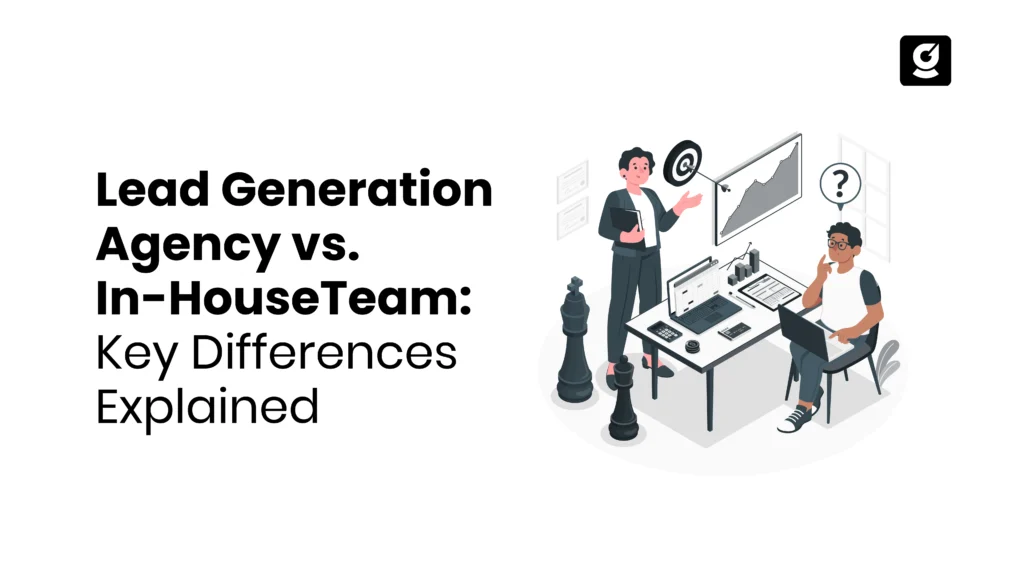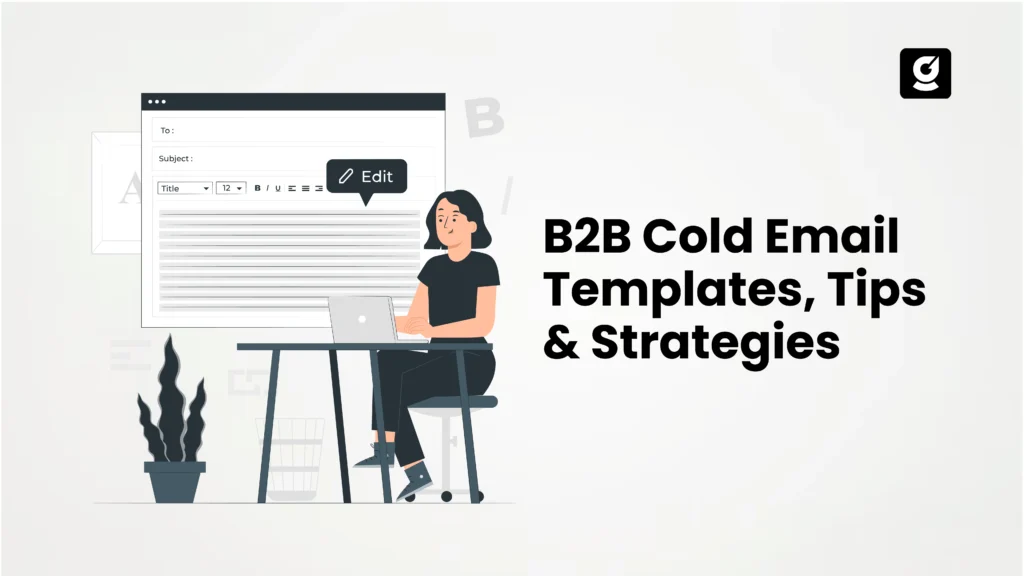Growing a SaaS business isn’t just about having a great product, it’s about getting it in front of the right people. But reaching potential customers who don’t know you yet can be tough. That’s why you should start cold emailing.
Cold emailing is one of the most effective ways to grow your SaaS business, but it’s tricky to get right.
Imagine trying to talk to a stranger who’s never heard of you—how do you make them care? Cold email outreach is a digital handshake: they introduce your product, explain why it matters, and convince busy people to give you a chance. But if your emails feel spammy or generic, they’ll end up in the trash.
This guide breaks down cold emailing into simple, actionable steps. You’ll learn how to find the right people, write emails they’ll actually read, and turn strangers into loyal customers with no fancy jargon or overcomplicated strategies. Whether you’re a startup founder or a marketer, these steps will help you build a campaign that feels personal, professional, and purposeful.
Let’s get started!
How to Run a Successful Cold EmailOutreach Campaign for SaaS – Step-by-Step
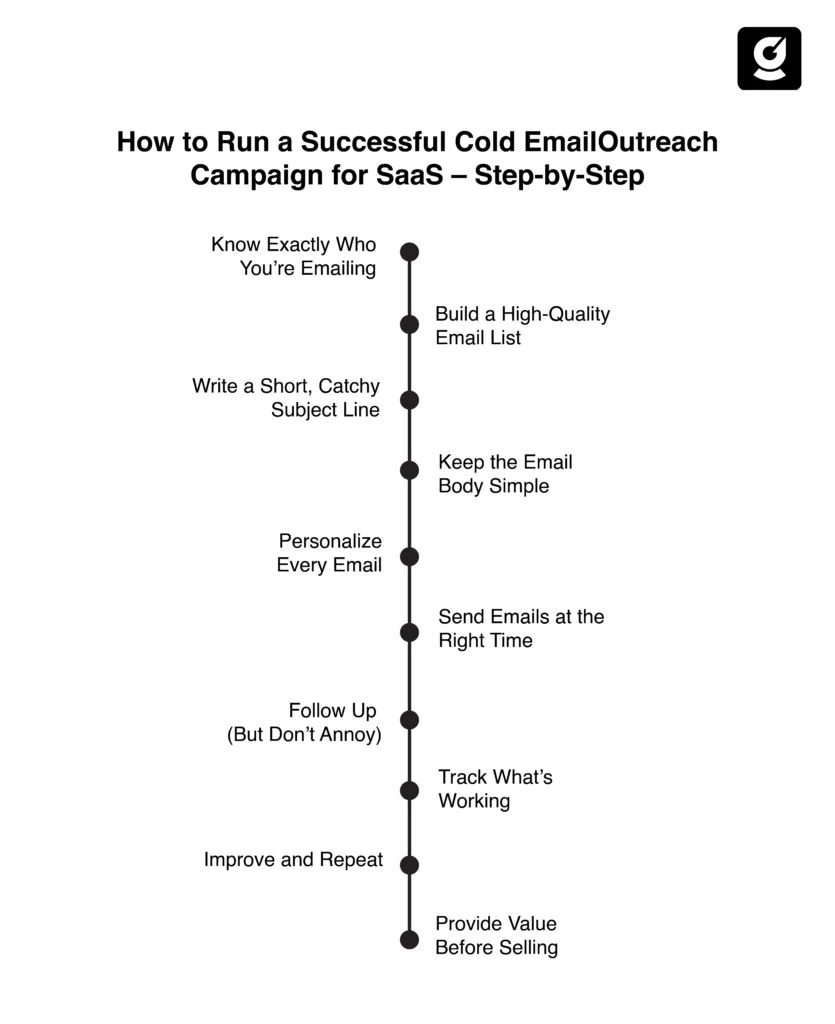
1. Know Exactly Who You’re Emailing
Before hitting send, it’s crucial to clearly identify and understand your target audience. A successful cold email campaign begins with defining your ideal customer. This involves examining which industries would benefit most from your solution, what specific job titles the decision-makers hold, and the day-to-day challenges they encounter.
For instance, if your SaaS tool streamlines team collaboration, you should focus on project managers in industries like technology or manufacturing, where missed deadlines can have significant consequences.
Take the time to research these professionals, looking into their responsibilities and pain points. By gathering such detailed information, you ensure your email content is directly relevant and valuable to the recipient. This level of precision in targeting not only increases open rates but also builds credibility and trust, which are essential for generating meaningful leads.
- Identify industries where your product solves a clear problem (e.g., healthcare, retail).
- Target decision-makers (e.g., IT Directors, Operations Managers).
- Research common challenges (e.g., outdated tools, communication gaps).
2. Build a High-Quality Email List
A targeted email list ensures you’re reaching people who need your solution. Use tools like Hunter.io or Clearbit to find professional emails directly from company websites. Avoid buying lists—they’re often outdated and full of irrelevant contacts. Start with a small batch (50–100 emails) to test your approach before scaling.
- Use Hunter.io to find emails by company domain and job title.
- Filter leads based on your ideal customer profile (Step 1).
- Verify emails with tools like NeverBounce to reduce bounce rates.
3. Write a Short, Catchy Subject Line
Your subject line decides if your email gets opened. Keep it under 6–8 words and focus on curiosity or value. For example, “Quick tip for [Industry] teams” or “Cutting [Problem] by 50%” work well. Avoid spammy phrases like “Limited offer!” or vague lines like “Let’s connect.”
- Good: “3 ways to fix [Problem]” or “Saving time for [Industry] teams.”
- Bad: “Urgent!” (too pushy) or “Hi there” (too generic).
- Use the recipient’s company name or industry for relevance.
4. Keep the Email Body Simple
Busy people skim emails, so keep yours short and clear. Follow this with a short, engaging introduction that may reference a recent company achievement or a piece of content they’ve shared.
The main section should clearly articulate the problem they are facing, coupled with a brief explanation of how your product or service can provide a solution. End with a clear call to action, such as scheduling a quick call or requesting a demo.
- Greeting: Use their first name (“Hi Sarah”).
- Personal Touch: Mention their blog post, company news, or industry pain point.
- Problem + Solution: Explain how your tool solves their specific challenge.
- Call to Action (CTA): End with a simple ask, like scheduling a call.
Example Email:
Hi [Name],
I noticed [Company] recently expanded its remote team—congrats!
Our tool, [Your SaaS], helps distributed teams hit deadlines 30% faster by simplifying task management. Could we chat about how this might work for you?
Best,
[Your Name]
- Start with a personalized opener (e.g., “Loved your recent webinar on [Topic]”).
- Focus on their problem, not your product’s features.
- Include one clear CTA (e.g., “Reply to schedule a demo”).
5. Personalize Every Email
Generic emails get deleted. Add 1–2 personal touches to show you care. For example, reference a blog post they wrote or a company milestone or mention a mutual contact from an industry event or simply avoid lazy personalization like “I see you work at [Company]” and dig deeper. Or mention a recent accomplishment or project that relates to the service you’re offering.
This approach makes your email feel tailored and sincere, demonstrating that you care about solving their particular problem rather than just pushing your product. By investing in personalization, you significantly increase engagement rates, foster stronger relationships, and build trust that could eventually lead to successful conversions.
- Use tools like Google Alerts to track company news.
- Mention their content: “Your article on [Topic] was insightful!”
- Highlight shared connections: “We both worked with [Client Name].”
6. Send Emails at the Right Time
Timing impacts open rates. Send emails mid-week (Tuesday–Thursday) when people are focused. Aim for 9–11 AM or 2–4 PM—common email-checking hours. Tools like Mailchimp let you schedule emails automatically. Avoid weekends or holidays.
- Best days: Tuesday–Thursday.
- Best times: Mid-morning or mid-afternoon.
- Adjust for time zones if targeting global leads.
7. Follow Up (But Don’t Annoy)
Most people need 2–3 follow-ups to reply. Keep messages polite and spaced 3–4 days apart. Example:
Hi [Name],
Just circling back—did you get a chance to review this?
If now’s not a good time, let me know!
Best,
[Your Name]
- Follow up 2–3 times.
- Add value in each follow-up (e.g., share a case study).
- Stop if they say “no” or don’t reply after 3 tries
8. Track What’s Working
Use metrics to improve your campaign:
- Open rate (30%+): Test different subject lines.
- Reply rate (5–10%): Improve email relevance.
- Unsubscribe rate (<0.5%): Avoid being too pushy.
- Tools like HubSpot or Mailtrack track these metrics for you.
- A/B test subject lines and CTAs.
- Remove underperforming emails from your sequence.
- Focus on quality over quantity.
9. Improve and Repeat
Cold emailing is a process of testing and refining. Experiment with one change at a time, like shorter emails or new CTAs. Double down on what works (e.g., “free trial” offers more replies than “demo”) and drop what doesn’t.
- Test variables: Email length, tone, and CTAs.
- Update your email list monthly to keep it fresh.
- Scale strategies that get replies.
10. Provide Value Before Selling
Cold emails that offer value upfront perform better than those that jump straight to a sales pitch. Examples of offering value:
- Share a free resource like a case study or a helpful article.
- Offer a free trial or demo of your SaaS.
This shows recipients that you’re more interested in solving their problems than just making a sale.
growth.cx: SaaS Email Marketing Driving Growth
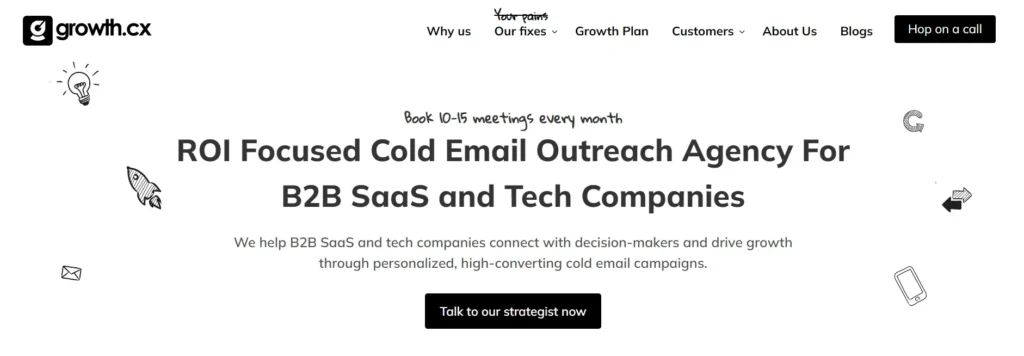
At growth.cx, we help SaaS companies grow with smart cold email outreach marketing. Our team creates and manages email campaigns that attract the right audience, boost engagement, and increase conversions.
We understand the unique challenges of SaaS marketing, so we craft personalized, data-driven emails that connect with potential customers. Whether it’s drip campaigns, cold outreach, or engaging newsletters, our strategies ensure your brand stays top-of-mind.

At growth.cx, we specialize in delivering highly effective cold email outreach campaigns designed to cut through the noise and reach the right audience. Our approach focuses on understanding your unique value proposition and creating personalized messages that directly address your audience’s needs.
Need help? At growth.cx, we specialize in creating cold email campaigns that actually work for SaaS brands. Let’s turn your outreach into growth!


